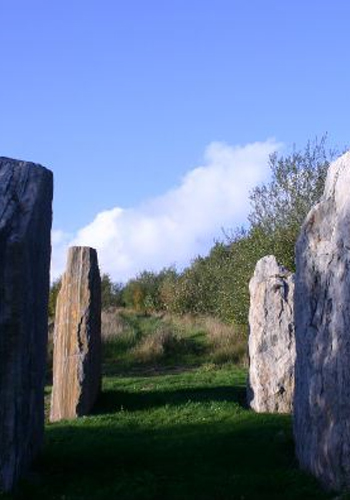A POST-INDUSTRIAL STONEHENGE RISES IN SCOTLAND
As Scotland becomes one of the first countries to run solely on renewable energy, communities face the question of what to do with the country’s abandoned mining infrastructure. In one Scottish village, Sanquhar, the answer is to transform a former coal mine into a 55-acre, $1 million work of land art. Conjuring images of Stonehenge, Crawick Multiverse, which opened July 10 with a ceremony of music and dance, was built from materials found on-site, including 2,000 boulders half-buried below ground.
At the urging of local residents, the landowner, Richard Scott, the Duke of Buccleuch, commissioned landscape artist Charles Jencks to build something dynamic that would benefit the region, which has been struggling economically. Crawick Multiverse, “represents the cosmos, from the Milky Way and Andromeda galaxies to a spiral of rocks that make up the multiverse.” While Jencks often draws inspiration from astronomy, at the nearby Garden of Cosmic Speculation for example, Fast Company writes that it was also a natural fit for this site, where prehistoric stone art and Celtic gold necklaces designed to represent the moon have been found nearby.
Traditionally, former coal mines in the country are bulldozed and returned to the pastures they once were, but this misses an opportunity to reflect the cultural significance of a site. “Around the world, mines produce an environment which is depressing, and derelict and desolate and deserted, full of junk,” Jencks told Fast Company. “There have been laws put in place to restore these areas to their pristine original quality — that often means putting grass over the site, plowing it back, and returning it to the cows. We wanted to build something positive for the community instead.” By using on-site materials to create the dramatic earthworks rather than flattening the site, construction costs were also reduced.
A network of paths weave through the sites four different ecosystems (grassland, mountain, water gorge and desert), while navigating landforms represent the sun, universes, galaxies and comets. At the heart of the project is a 5,000-person amphitheater inspired by a solar eclipse.
Dramatic earthworks include the two galaxy mounds – Andromeda and the Milky Way – which stand at 25 and 15 meters high, respectively. The mounds represent “the cosmic ballet of the two galaxies coming together,” and each have lagoons that add to their visual impact.
The site was once valued for its industrial purpose, but there is a beauty in the surrounding landscape that Jencks sought to emphasize in the design. The comet walk — a ridge trail with white-yellow sandstone emulating comets’ tails — leads to the Belvedere, a lookout offering a panoramic view of the surrounding countryside. Again, stones from the site have been repurposed, this time into a stone hand with a finger pointing to the North Star.
“Destroyed sites are an opportunity to renew. It’s wonderful to see this park used in different ways. For a designer, such as me, that’s the pay-off,” Jencks explains in a video for the project. “This site is big enough to absorb 10,000 people a day and you wouldn’t feel crowded, so I’m really happy about that. It’ll take time to get there, but I’m sure it will be used in thousands of different ways we can’t even predict. All successful parks have to embed themselves with the locals who will use them in new ways.”
The project is potentially the beginning of an exciting series of reclamation projects poised to take hold in Scotland’s post-industrial landscape. As coal mining becomes increasingly obsolete across the country, Crawick Multiverse, in its striking whimsy, offers a practical strategy for industrial redevelopment at the landscape scale.
See a video of Jencks discussing his inspiration for the project:












Follow Us!